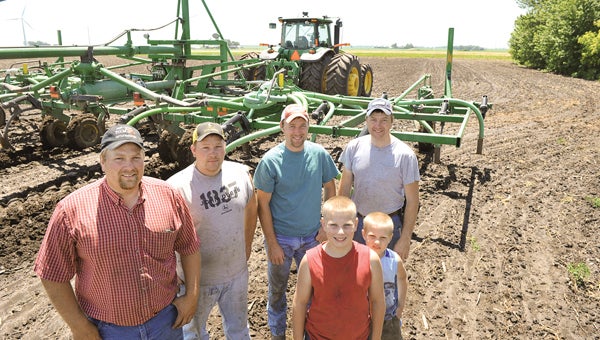Employment their way: Dirty work
Published 12:53 pm Monday, July 2, 2012

Darin Voigt, left, and his brothers Dallas, Dustin and Devin, pictured with Darin’s sons Andrew and Wyatt, pump manure out of feed lots onto fields. -- Eric Johnson/photodesk@austindailyherald.com
From family traditions to at-home jobs to second jobs, there’s plenty of unique things about Mower County’s work
Editor’s note: This is the first in a four-part series. Look for parts two through four July 3, 4 and 5.
Darin Voigt puts up with a lot of crap on his side job — literally.
Voigt, along with his brothers, pumps hog manure from feedlots onto fields as a job to supplement income at the family farm near Taopi.
“It’s our job in town that’s not in town,” he said.
Though it may sound like a good candidate for the TV show “Dirty Jobs,” Voigt says the process is actually quite clean, and they rarely go home gross or smelly.
“My wife still opens the door for me every night yet if that means anything,” he said.
The Voigts use the drag hose method to move the manure, where a main pump is placed at a barn’s manure pit. The waste run through a high pressure pump that transfers the waste through 6-inch hoses. The hoses hook up to an applicator connected to a chisel on back of a tractor that mixes the manure in with the soil in nearby fields.
“It’s a real clean, simple thing,” he said. “It takes a little getting used to, but once you get used to it, it’s a pretty slick, efficient way to move it.”
The drag hoses have positives and negatives. The waste is never hauled or stored in trucks, which reduces traffic and wear and tear on fields and lawns.
“There’s no more pressure on the field than if you were out working the ground,” he said.
However, the waste can only be transported as far away as the hoses reach. The Voigts currently have about four miles of hose. Voigt said he could pump it all the way from Taopi to Austin if he wanted, but booster pumps are required to keep the flow moving about every mile — not to mention the cost of the hose.
The Voigt’s didn’t start the process overnight. They had to attend training to be certified in how to properly spread the waste and learn about setback limits from streams and open tile. Voigt and his brothers get re-certified or attend refresher courses each year in Minnesota and Iowa.
“It’s more than just finding some old equipment and going out and running it,” he said.
Aside from getting rid of the waste at hog farms, the manure is quite a valuable fertilizer for farmers.
“Hog farms are like a fertilizer manufacturing plant,” Voigt said. The Voigts even send in samples to test the amount of nutrients left on the soil.
Voigt said hog fertilizer is typically safer and more effective than commercial fertilizers, as long as it’s done properly.
The family is careful not to affect the environment, and Voigt said there’s usually almost no impact or noise for the surrounding area.
That’s not to say there’s no sign of the workers applying manure.
Nearby residents can sometimes smell the waste — especially if there’s a strong wind — for a few days after it’s spread. Voigt said they typically tell homeowners nearby when they’re going to be working, and they can work with people if there’s a family reunion or event taking place.
The peak season for injecting manure into the fields is the end of October through Thanksgiving. April and early spring can also be busy. The Voigt’s occasionally spread manure in the winter, but it’s only for an emergency if a facility is full.




